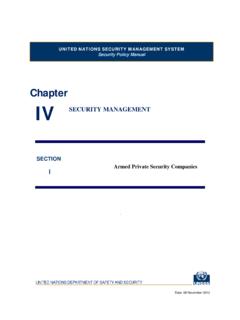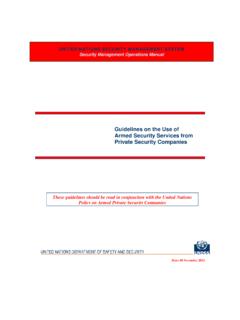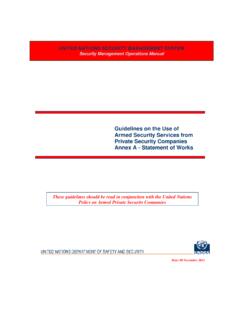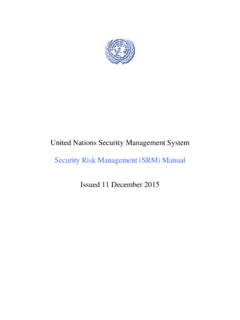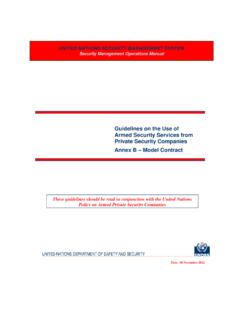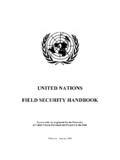Transcription of Chapter IV SECURITY MANAGEMENT - Home | Food and ...
1 SECURITY MANAGEMENT Measures to Avoid Risk INTERIM policy . Date: UNITED NATIONS SECURITY MANAGEMENT SYSTEM SECURITY policy manual Chapter IV SECTION D unsms SECURITY policy manual Chapter IV: SECURITY MANAGEMENT D. Measures to Avoid Risk Interim policy - 1 A. Introduction: 1. The United Nations policy on SECURITY Risk MANAGEMENT categorizes decisions on how to manage risk as accept, control, avoid and/or transfer (see SECURITY policy manual , Chapter IV, policy and Conceptual Overview of the SECURITY Risk MANAGEMENT Process , paragraph 13). As part of a broader SECURITY risk MANAGEMENT strategy, the Designated Official may temporarily remove personnel and/or eligible family members from an area or situation of unacceptable risk as a means of managing that risk ( , avoiding the risk).
2 This Chapter lays out the parameters, as well as the roles and responsibilities of relevant actors, regarding the three basic options for avoiding risk used by the United Nations SECURITY MANAGEMENT System: a. Alternate Work Modalities (temporary closure of offices, work-from-home for personnel, stay-at-home orders for eligible family members, etc.) b. Relocation c. Evacuation B. Purpose: 2. The purpose of this policy is to lay out the parameters of measures to avoid risk as part of SECURITY Risk MANAGEMENT , including alternate work modalities, relocation and/or evacuation, and to clarify the roles and responsibilities of relevant United Nations SECURITY MANAGEMENT System actors in these decisions. C. Application/Scope: 3. The policy is applicable to all individuals covered by the United Nations SECURITY MANAGEMENT System, as defined in Chapter III of the SECURITY policy manual ( Applicability of SECURITY Arrangements ).
3 D. Conceptual Framework: 4. SECURITY Risk MANAGEMENT is the fundamental United Nations tool for managing risk. The SECURITY Risk Assessment assesses the level of risk of specific threats to the United Nations. Based on the SECURITY Risk Assessment, different SECURITY measures may be implemented to reduce the level of risk to acceptable levels and enable the UN to continue operations. 5. One SECURITY risk MANAGEMENT option is to avoid risk by temporarily removing persons or assets from a situation of unacceptable residual risk by using alternate work modalities, relocation or evacuation (or their combination). Indeed, until proper measures to control and lower risks are put in place, avoiding risk is the only option when residual risks are deemed unacceptable (See Guidelines for Acceptable Risk , paragraph 6) unsms SECURITY policy manual Chapter IV: SECURITY MANAGEMENT D.
4 Measures to Avoid Risk Interim policy - 2 6. Any decision to avoid risk must take into consideration the impact of the removal of personnel and/or eligible family members on United Nations programmes and activities, including SECURITY and/or business continuity plans. Avoiding risk can be a cost-effective way to manage risk, and it is best suited for situations when resource limitations prevent the implementation of proper risk controls or when there has not been enough time to implement proper risk controls (for details on risk control , see SECURITY policy manual , Chapter IV, policy and Conceptual Overview of the SECURITY Risk MANAGEMENT Process , paragraph 13b). F. Alternate Work Modalities 7. Alternate Work Modalities are defined as measures that limit or totally remove the number of personnel or family members at a specific location(s), short of official relocation or evacuation, with the view to limit or remove their exposure to a sudden situation that creates unacceptable residual risk.
5 8. Alternate Work Modalities include, but are not limited to, temporarily limiting or removing the number of personnel at a United Nations premise, ordering school-aged family members to stay out of school temporarily, or creating no-go areas in urban areas where personnel and family members cannot visit at certain times. 9. Alternate Work Modalities are effective SECURITY risk MANAGEMENT strategies for when there is no time to implement adequate risk controls, if such controls are not cost-effective, or if there is not enough information to determine what risk controls are needed. 10. Decisions on Alternate Work Modalities that involve temporarily closing offices or work-from-home arrangements must be made in accordance with United Nations Human Resources rules and regulations. G. Evacuation and Relocation 11. Relocation is defined as the official movement of any personnel or eligible dependant from their normal place of assignment or place of work to another location within their country of assignment for the purpose of avoiding unacceptable risk.
6 Relocation is a risk avoidance measure that can be applied to all personnel and eligible family members. 12. Evacuation is defined as the official movement of any personnel or eligible dependant from their place of assignment to a location outside of their country of assignment (safe haven country, home country, or third country) for the purpose of avoiding unacceptable risk. Except in the situations as outlined in paragraph 13 below, evacuation is a risk avoidance measure that can be applied only to internationally-recruited personnel and their eligible family members. The evacuation of eligible family members of internationally-recruited personnel is governed by the same eligibility conditions as for the payment of evacuation allowances as per Section A, Sub-Section III, paragraph 9 of Annex xx entitled unsms SECURITY policy manual Chapter IV: SECURITY MANAGEMENT D.
7 Measures to Avoid Risk Interim policy - 3 Remuneration of United Nations System Staff and Eligible Family members on Relocation/Evacuation Status 13. Locally-recruited personnel and/or their eligible family members may be evacuated from a duty station only in the most exceptional cases in which their SECURITY is endangered as a direct consequence of their employment by organizations of the United Nations common system. A decision in this regard can only be made by the Secretary-General, as recommended by the Under-Secretary-General for Safety and SECURITY , based on a recommendation by the Designated Official. Personnel and/or their eligible family members not covered by paragraph 12 above may also be assisted to leave the country by the organization, when possible and to the extent feasible, and on a reimbursable basis, as per SECURITY policy manual , Chapter xx ( Crisis MANAGEMENT ), Section xx, Assistance to Other Persons.
8 H. Roles and Responsibilities 14. The Designated Official, in consultation with the SECURITY MANAGEMENT Team and based on the advice of the most senior SECURITY professional directly supporting the Designated Official1 , may institute planned or ad hoc Alternate Work Modalities for all or some United Nations personnel and eligible family members to address specific SECURITY problems in their area of responsibility in accordance with Section F above. Contingencies for Alternate Work Modalities should be included in the SECURITY Plan and any on-going Alternate Work Modality (such as no-go areas in a city) should be included in the country-specific Minimum Operating SECURITY Standards. 15. Representatives of organizations participating in the United Nations SECURITY MANAGEMENT System can also institute Alternate Work Modalities solely for their personnel in response to agency-specific risks.
9 This derives from their responsibility and authority in the United Nations Framework of Accountability for SECURITY . Representatives wishing to implement such measures should examine any possible negative impact these measures would have on SECURITY and/or business continuity plans, and they should also consult with other members of the SECURITY MANAGEMENT Team to examine whether these decisions would have any negative impact on the SECURITY of other United Nations personnel in the country. 16. The Designated Official, in consultation with the SECURITY MANAGEMENT Team, may recommend the relocation or evacuation of personnel and/or eligible family members when residual risks are deemed unacceptable, regardless of the SECURITY Level. This recommendation is submitted through the Under-Secretary-General for Safety and SECURITY to the Secretary-General.
10 After assessing the situation, the 1 This is usually the Chief SECURITY Advisor (CSA) or other SECURITY Advisor (SA). Where a Chief SECURITY Advisor or SECURITY Advisor is not present, this term is equivalent to the titles of Chief SECURITY Officer and Chief of SECURITY and Safety Services or Country SECURITY Focal Point (CSFP) in countries where no international professional SECURITY advisor has been assigned or present. unsms SECURITY policy manual Chapter IV: SECURITY MANAGEMENT D. Measures to Avoid Risk Interim policy - 4 Under-Secretary-General for Safety and SECURITY makes a recommendation to the Secretary-General for approval of evacuation or relocation. 17. Upon the Secretary-General s approval of the recommendation, the Under-Secretary-General for Safety and SECURITY distributes an All Agency Communiqu to the UN System announcing the details and parameters of the relocation and/or evacuation.










